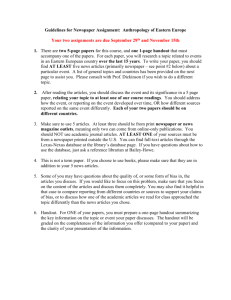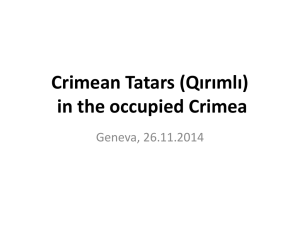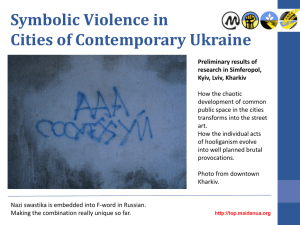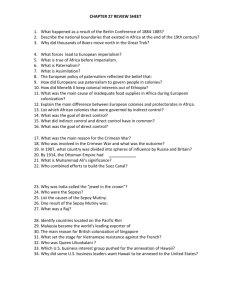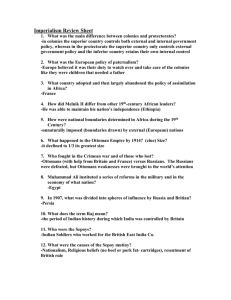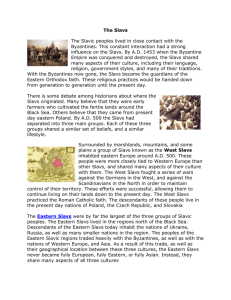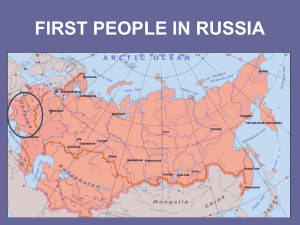The Socia l-Psycholog¡cal Roots of the Ethnic Problems in Crimea
advertisement
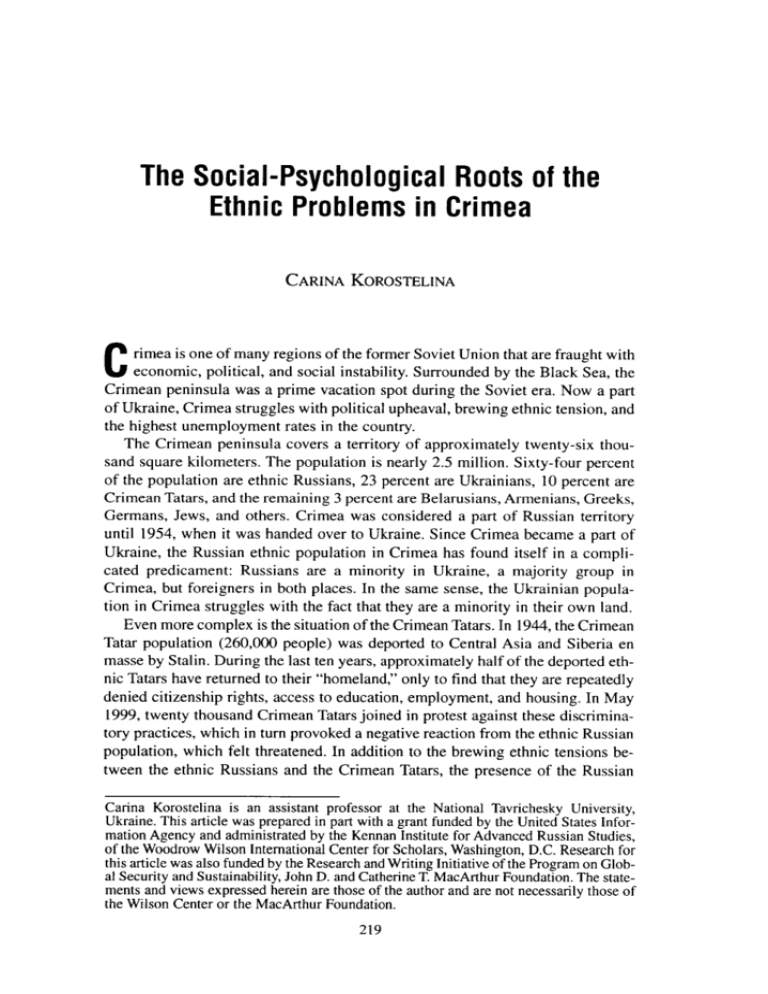
The Socia l - Psycholog¡cal Roots of the Ethnic Problems in Crimea CARINA KOROSTELINA C rimea is one of many regions of the former Soviet Union that are fraught with economic, political, and social instability. Surrounded by the Black Sea, the Crimean peninsula was a prime vacation spot during the Soviet era. Now a part of Ukraine, Crimea struggles with political upheaval, brewing ethnic tension, and the highest unemployment rates in the country. The Crimean península covers a territory of approximately twenty-six thousand square kilometers. The population is nearly 2.5 million. Sixty-four percent of the population are ethnic Russians, 23 percent are Ukrainians, 10 percent are Crimean Tatars, and the remaining 3 percent are Belarusians, Armenians, Greeks, Germans, Jews, and others. Crimea was considered a part of Russian territory until 1954, when it was handed over to Ukraine. Since Crimea became a part of Ukraine, the Russian ethnic population in Crimea has found itself in a complicated predicament: Russians are a minority in Ukraine, a majority group in Crimea, but foreigners in both places. In the same sense, the Ukrainian population in Crimea struggles with the fact that they are a minority in their own land. Even more complex is the situation of the Crimean Tatars. In 1944, the Crimean Tatar population (260,000 people) was deported lo Central Asia and Siberia en masse by Stalin. During the last ten years, approximately half of the deported ethnic Tatars have returned to their "homeland," only to find that they are repeatedly denied citizenship rights, access to education, employment, and housing. In May 1999, twenty thousand Crimean Tatars joined in protest against these discriminatory practices, which in turn provoked a negative reaction from the ethnic Russian population, which felt threatened. In addition to the brewing ethnic tensions between the ethnic Russians and the Crimean Tatars, the presence of the Russian Carina Korostelina is an assistant professor at the National Tavrichesky University, Ukraine. This article was prepared in part with a grant funded by the United States Information Agency and administrated by the Kennan Institute for Advanced Russian Studies, of the Woodrow Wilson International Center for Scholars, Washington, D.C. Research for this article was also funded by the Research and Writing Initiative of the Program on Global Security and Sustainability, John D. and Catherine T. MacArthur Foundation. The statements and views expressed herein are those of the author and are not necessarily those of the Wilson Center or the MacArthur Foundation. 219 220 DEMOKRATIZATSIYA Black Sea fleet at Sevastopol further exacerbates political tensions between Ukraine and Russia. Today, the Crimea remains threatened by competing ethnopolitical ambitions, and the potential for further unrest is significant and troubling. Ukraine's national budget has been severely crippled by the Russian economic crisis and a growing burden of debt. The government is ill equipped to handie the deteriorating situation in Crimea. Limited financial resources that were intended to aid the region have been curtailed or eliminated from the state budget. Fortunately, in the Crimea and throughout Ukraine, the conflicts among different ethnic groups and their political elites have not resulted in any violence or armed clashes, as has happened in many regions of the former USSR. In March 1995, after several years of concessions and a policy of noninterference in the intemal affairs of the Autonomous Republic of Crimea (ARC), the central authorities took the first decisive step toward a legal-political solution of the conflict between the constitution of Ukraine and the Crimea. In March 1995 the Supreme Rada of Ukraine annulled all legislative acts of the ARC that were not consistent with Ukrainian legislation. The institution of the presidency was abolished, and the law "On the Autonomous Republic of the Crimea" was adopted. During the last sixty years, as a result of migration, the ethnic structure of the population of Crimea has changed considerably. In traditionally multinational and stable Crimea, the balance of material resources and multicultural harmony has been broken, and problems of an ethnic nature have sprung up. Yet Crimea, as no other region, has the structures to develop once again into a multicultural state and to solve its problems by mutual agreement. For thousands of years, various ethnic groups have peacefully coexisted in Crimea. Even during times of war and invasions, no war or historically significant conflict has ever involved interethnic strife. Crimea is also known as "the good neighborhood" of different religions and throughout history has remained hospitable to the followers of various religious beliefs who have inhabited the península. Nowadays, with religious conflicts on the rise, Crimea serves as a good example to the rest of the world, as a place where Muslims peacefully coexist alongside Christians. However, various analyses of the current social situation in Crimea show that one of the prime reasons for tension is that the government is operating between both West-focused and East-focused ideologies. The oficial governing bodies do not always adequately understand the needs of the Crimean Tatar and the Slavic populations. Currently, the governing bodies are attempting to pursue a policy of affirmative action and cross-cultural adaptation and are using peacebuilding to resolve ethnic conflict in the Crimea. The concept of peacebuilding was proposed by Boutros Boutros-Ghali in "An Agenda for Peace" in 1992. Three elements are central to the concept of peacebuilding: (a) the rehabilitation, reconstruction, and reconciliation of societies that have suffered the ravages of armed conflict; (b) the creation of the security-related, political and/or socioeconomic mechanisms needed to build trust between the opposing parties in order to prevent violence; and (c) external (foreign) intervention (at the national or multilateral level or by the UN) to help create conditions conducive to peace. Ethnic Problems in Crimea 221 Peacebuilding is one of the popular concepts underpinning UN missions today. However, case studies of peacebuilding show that the standards peacebuilding calls for often conflict with prevailing local conditions, even when the countries involved had undergone democratization, adopted a market economy, and followed the advice of international organizations and agencies. Now scholars and political activists have begun to stress that successful peacebuilding must be based on the social-psychological models of a given society. In this article, 1 will attempt to describe how ethnic and cultural peculiarities may influence both ethnic conflict and peacebuilding. A person trying to live within the boundaries of a particular society inevitably is shaped by and reacts to the moral, legal, economic, and political norms of that society. This reaction creates an inner attitude-a social or a value system. Each person does not simply react to stimulus, but uses stimulus to create his own Weltanshauung (or theory of the world). Consciousness creates cognitive models of ethnic situations on the basis of cultural and national representations and the subjective experience of the members of society. As was shown in the research of T. A.Van Deik, negative characteristics of one member of an ethnic group are oftentimes ascribed to the whole group. In such cases, stereotypes of and reactions to the behaviors of other peoples are formed. Cognitive structures prevent one from adequately estimating not only situations and laws that provoke conflict, but also the needs of other people and national groups. But if people cannot satisfy their needs within the frameworks of existing social institutions, then they begin to work outside of these frameworks. Therefore, it is necessary to conduct a careful analysis of both the needs of the national groups and their degree of satisfaction with the existing social situation. To analyze how ethnicity and culture influence ethnic conflict, 1 conducted research in different towns and villages of Crimea, interviewing, surveying, and administering questionnaires to more than three hundred Crimean Tatars and Slavs. 1 then carne to my conclusions about my findings using such social-psychological methods as analysis of stories about ethnic relations, analysis of constructs of consciousness, and analysis of motivations and emotions. How Crimeans and Slavs Perceive Each Other Analyses of stories told by Crimean Tatars and Slavs about their interaction with representatives of other ethnicities reveal the cognitive models of interaction that influence personal attitudes toward other ethnicities. After comparing these stories, it is possible to make the following general conclusions: 1. The stories of the Crimean Tatars are very similar and usually only concern interaction with strangers in public places. The stories of the Slavs are more varied, describing everyday contacts with Crimean Tatars in daily life, in neighborhoods, and at work. 2. All the stories that Crimean Tatars told portray Slavs negatively, while the Tatars are perceived positively in 30 percent of the stories of the Slavs. 3. Crimean Tatars perceive situations of public insult, rejection, or antagonism 222 DEMOKRATIZATSIYA as very painful but are less concerned about everyday squabbles (they are scarcely mentioned in the stories). The Slavs react sharply to negative interaction even in everyday conditions. 4. Crimean Tatars described only their personal interaction with Slavs, whereas relatives, friends, or acquaintances act as protagonists in 25 percent of the stories told by Slavs. 5. The stories of Crimean Tatars used no generalizations, but the stories of the Slavs used generalizations rather often; in 45 percent of al] stories there are such statements as, "All the Tatars ..." and so on. 6. In general, Crimean Tatars feel that interethniic relations are more tense, since they see the Slavs as bearers of negative opinions and information. The attitude of the Slavs toward the Crimean Tatars is more ambivalent; they expect both negative and positive actions from Tatars. Surprisingly, the Crimean Tatars describe their own ethnicity more negatively than the Slavs do. In contrast, the Slavs are perceived by the Crimean Tatars as more aggressive and antagonistic than the Slavs think themselves to be. In situations described by the Slavs, the Crimean Tatars quite often initiate conversation with requests and offers, but many Slavs consider such actions negatively. The Crimean Tatars never describe themselves as initiators, attributing the responsibility for conflict to the Slavs. 7. The Slavs, in stories about their own experiences and those of other Slavs, describe themselves as having various emotions. But the Crimean Tatars attribute only negative emotions to the Slavs, aboye all anger and disgust. The Slavs' stories pay little attention to the emotions of Crimean Tatars, but like the Tatars mostly ascribe anger to the other ethnic group. The lack of interest in the emotional state of the other party is frequently the reason for the strong tensions Slavs and Tatars feel when they communicate with one another. 8. The Crimean Tatars commonly perceive themselves and Slavs as absolutely disparate groups, having minimal interaction. The Slavs generally see Crimean Tatars merely as neighbors in the same society; however, this attitude is shaded with some antogonism. Autostereotypes and Heteroster,eotypes Analysis of stereotypes can help us to understand how ethnic groups perceive one another. Autostereotypes (the way one lees one's own ethnicity) of Crimean Tatars are much less positive than those of the Slavs. The Crimean Tatars tend to mentally separate themselves from the majority of their ethnicity, seeing themselves individually as better than other Crimean Tatars. The Slavs, on the other hand, see their people as basically sociable, open, and intellectual, as well as witty, tactful, economical, easy-going, courageous, and inquisitive. Slavs usually think of themselves as more tactful and warm in communication than other Slavs, but less witty and bold. They think that the typical Slav lacks qualities connected with personal contact and inquisitiveness. Crimean Tatars estimate their people, first of all, as very self-confident, with related qualities of straightforwardness, punctuality, and social ease. But they sometimes see their neighbors as more conceited than self-confident. Thus they condemn Ethnic Problems in Crimea 223 many behaviors of Crimean Tatars in general while justifying their own similar behavior. For instante, Crimean Tatars see themselves as cautious (instead of cowardly, as they autostereotype other Crimean Tatars), carefree (instead of thoughtless), cheerful (instead of noisy), complacent (instead of spineless). They see themselves as more kind, witty, tactful, and sociable than the majority of the Crimean Tatars. The autostereotypes of the two ethnicities coincide in only two positive characteristics: social ease and straightforwardness. And although both an objective and subjective psychological distance appears to be rather high between them, these characteristics could nevertheless help reach mutual understanding with sincere, easy communication. In comparison with the heterostereotypes (ideas about an"positive stereotypes can other ethnicity) of the Slavs, the heterostereotypes of the Crimean Tatars are rather negative. The Slavs stereotype the Crimean Tatars as prudent, self-righteous, help establish more mutual understanding and sincere communication between the peoples of Crimea." economical, hypocritical, cunning, nervous, and rough. In the opinion of the Slavs, the Crimean Tatars lack tact, courtesy, restraint, sensitivity, straightforwardness, wittiness, and inquisitiveness. But while the typical Tatar does not meet an ideal, neither does he utterly contradict it. The stereotypes of the Crimean Tatars concerning the Slavs are less developed than their autostereotypes about other Crimean Tatars, and they are more negative. Crimean Tatars express positive heterostereotypes poorly, mentioning such qualities as caring, wittiness, tact, inquisitiveness, and boldness. They also admire the Slavs' culture and education levels, their intelligence, and their free thinking. That the Slavs "treat others with neglect" and that they are flattering, noisy, rough, and greedy are agreed upon as the most common negative heterostereotypes of the Crimean Tatars toward the Slavs. But Crimean Tatars also described Slavs as arrogant, uncivilized, inhospitable, thoughtless, drunken, and lacking in family traditions or closeness. As negative heterostereotypes, members of both ethnicities use terms like "flattering," "noisy," and "rough." Heterostereotypes often have the goal of denying the other ethnicity those characteristics that are the most highly valued by their own ethnicity. This tendency is more pronounced for Crimean Tatars, who, reversing the autostereotype "self-confident," use "lacking self-confidence" four times more often than other negative heterostereotypes to describe the Slavs. As negative heterostereotypes are a mark of mistrust in interethnic contacts, it is clear that both groups see interethnic relations as insincere and negative, with a lack of mutual respect. However, this research has also shown signs of improvement in mutual relations, since both Crimean Tatars and Slavs mentioned positive heterostereotypes of the other ethnicity. These positive stereotypes can help establish more mutual understanding and sincere communication between the peoples of Crimea. 224 DEMOKRATIZATSIYA Four positive qualities are mentioned in both the autostereotype of the Slavs and the ideas of the Crimean Tatars about the Slavs: wittiness, tactfulness, inquisitiveness, and boldness. There are no concurrences in negative stereotypes. Stereotypes and autostereotypes of the Crimean Tatars concurred in only one positive quality-self-confidence-although this quality has dual negative and positive overtones. There is also a concurrence in the negative quality of noisiness. Such concurrence of perceptions shows that in spite of negative tendencies in interethnic relations, there is a rather large degree of mutual understanding between the Slavs and the Crimean Tatars. The Main Motives and Emotions Behind Behavior Analysis of values. Both ethnicities attach similar importance to the basic human values of health and family; values such as an active life, creativity, and efficiency in business are less important. The Crimean Tatars are more focused on personal well-being, entertainment, and learning . The most important values-family for the Crimean Tatars, and honesty and responsibility for the Slavs-are used to create a negative mirror image of the other ethnicity. In other words, since the Slavs see themselves as honest, they see the Crimean Tatars as dishonest. Analysis of emotions. Communicative emotions (those connected with dialogue) appear for the most part to be advanced for both ethnicities, and emotions connected with perserverance and the overcoming of difficulties appear to be the least developed. Communication for the Crimean Tatars is connected with their desires for glory, respect, and recognition. Dialogue with Crimean Tatars will be more fruitful if these feelings are taken into account; the underestimation of such emotional needs may result in conflicts. Altruistic emotions are well advanced in the Slavs; in interethnic dialogue, they can help create peace. Analysis of needs. There are essential distinctions in the ways both ethnicities view living conditions in Crimea. The Crimean Tatars are least satisfied with housing conditions and social security; the Slavs are least satisfied with health services and income levels. Both ethnicities are most1y satisfied with freedom of speech (a free press, the right to protest), freedom of religion, and the right to vote. The greatest sources for complaint are economic and social conditions. As a whole, Crimean Tatars are more tolerant of everyday problems and, more often than the Slavs, find support and consolation for problems among family members. Comparative Analysis of Attitudes As a whole, positive or tolerant attitudes toward Crirnean Tatars prevail among the Slavs. Many think that the Crimean Tatars are the same as the Slavs and that they need to be respected; they also believe that the Crimean Tatars seek a peaceful coexistente. One-third of Slavic attitudes toward Crimean Tatars, however, are negative. Slavs feel that the Crimean Tatars treat them as unintelligent aggressors-basically as enemies. It is known in psychology that negative expectations provoke negative behavior, which then confirms those expectations. The Slavs consider that the Crimean Tatars are prone to civil war and behave in an Ethnic Problems in Crimea 225 uncivilized manner. The Slavs become irritated when the Crimean Tatars talk of Crimea as their native land. While they pay little attention to Crimean Tatar families, they did comment on the diligence and beauty of Crimean Tatar women, as well as the large size and closeness of their families. The attitudes of the Crimean Tatars are largely tolerant: they consider the majority of the Slavs to be normal people, and they are ready to cooperate with them. They expect greater friendliness, ethnic tolerance, and respect for other peoples like them. But Crimean Tatars do not like displays of nationalism-for instance, when the Slavs treat other people badly, particularly Crimean Tatars, and then proceed to speak about their superiority and intelligence, while at the lame time refusing to learn the Crimean Tatar language. Interrelations of Spheres of Motivations and Needs The Crimean Tatars are interdependent incide their close circle of family and friends. They are unsatisfied with their situation because they are very aware of the needs of everyone in their circle. The satisfaction derived from nature and art, from leisure time, from feelings of pride, from the respect of others, and from public recognition depends completely upon their satisfaction with social and legal security, their situation in society, and housing conditions. Only then, when their life as a whole is better, will the representatives of the Crimean Tatar people take pleasure in other things. Hence, the Crimean Tatars are constantly in a dissatisfied state (which frequently surprises the Slavs) because they constantly struggle to satisfy their basic needs. The Slavs do not value family life (the main value of the Crimean Tatars), placing more emphasis on knowledge, creativity, and broad-mindedness, while the Crimean Tatars ignore honesty (the main value of the Slavs) in favor of nationalism and emotional intuition. The representatives of both ethnicities struggle to acknowledge the values of the other ethnicity: the Slavs regard family life as stagnant and boring, while the Crimean Tatars regard honesty as irrational. Representatives of both ethnicities think that education prevents one from taking satisfaction in conversations with friends and that family life will suffer if one overemphasizes knowledge and creativity. But family orientation is seen by the Slavs as close-minded, while the Crimean Tatars regard relations with relatives and friends as basic values. Slavs and Crimean Tatars also have varying needs for a sense of ethnic identity. In a survey, 51 percent of Crimean Tatars and 50 percent of Slavs expressed an average sense of ethnic identity. Six percent of Crimean Tatars showed ethnoegoism (a sense of ethnic superiority), as opposed to 2 percent of Slavs, while 12 percent of Tatars and 2 percent of Slavs considered themselves national fanatics. On the other hand, only 21 percent of Crimean Tatars felt indifferent toward their ethnicity, compared to 44 percent of Slavs. 1 also surveyed members of both ethnicities to determine what other factor (beside ethnicity) was the most important in the establishment of self-identity. Among the Crimean Tatars, family was mentioned by 24 percent as the most important factor; profession by 21 percent; personal character traits, 13 percent; gen- 226 DEMOKRATIZATSIYA der, 7 percent; religion, 4 percent; and subculture, 4 percent. Among Slavs, the most important factor was personal character traits, which was mentioned by 22 percent of those surveyed. Other responses included profession, 20 percent; family, 15 percent; gender, 15 percent; and ideology, 6 percent. The need for religious identity is poorly developed by the Tatars and is not displayed by the Slavs. The category of citizenship was practically not mentioned. What Motivates Tolerant/l[ntolerant Behavior? In my research, I questioned two groups of Crimean Tatars and two groups of Slavs, dividing them into those whose attitudes promote ethnic conflict (intolerant) and those whose attitudes avoid ethnic conflict (tolerant). 1 studied the motives and underlying feelings that lead to tolerant or intolerant behaviors. When comparing two conflicting groups, such as the Crimean Tatars and the Slavs, the distinctions in reasons for and displays of conflict behavior are visible. The basis of intolerant behavior in Crimean Tatars is a deep self-respect for their own people on the one hand, and unwillingness to recognize the humanity, the good nature, and the helpfulness of the Slavs on the other hand. Underestimation of the cultural values and education of the Tatars and, probably, their own levity and irascibility are the basis for the intolerant behavior of the Slavs. One more reason for conflicts is found in the features of national character. The lightmindedness and quick tempers of the Slavs irritate the Tatars, while the Crimean Tatars' great need for respect irritates the Slavs. The comparison of two tolerant groups also shows different reasons for peaceful behavior. The Crimean Tatars avoid conflicts because they are open-minded, optimistic, and humane. The Slavs do so because they are self-critical, moral, and good-natured. Hence, the intolerant behavior of the Slavic and the Crimean Tatar peoples is connected to their perception of the social validity of the other ethnicity. To understand the reasons behind negative feelings means to make a step toward each other. Both groups must tolerate the features of the other ethnicity as simply inherent, rather than considering them as negative qualities. Research has also shown the way to rapprochement between our peoples: through the Crimean Tatar people's humanity, understanding, readiness to help, and the Slavic people's self-criticism, good nature, and sociability. And certainly, the road toward understanding requires good will and familiarity with the culture and traditions of other people. The results of further research show that intolerant people are likely tojudge and jump to conclusions about the characteristics of other people. When such people see one quality in the behavior of another person, they automatically associate the person with other qualities. For example, very strong connections were discovered between the following qualities of the Crimean Tatars: cleverness, kindness, wisdom, generosity, responsibility, morality, and inquisitiveness. Having estimated a person as malicious, intolerant people will regard him simultaneously as silly, thoughtless, stingy, adapting. Having decided that a person is careless, intolerant people will automatically attribute to that person a whole array of other negative qualities, such as rage, levity, cowardice, unscrupulousness, and so on. People who Ethnic Problems in Crimea 227 have tolerant behavior rarely make generalized conclusions, but rather examine each person's qualities separately. Having decided that a person is clever, such people will estimate separately his kindness, his resoluteness, and his wisdom. Intolerant people see the world as rigid, determined, and not open to various interpretations. Therefore, the way to liberalize behavior and mitigate negative attitudes is by developing the ability to see the world as multifaceted. It is important that moral qualities translate into activity, responsibility, and care for the future. It is also necessary for intolerant people to understand that kindness and empathy are not synonyms of unscrupulousness and softness. Research shows that humans should first develop personal moral qualities, then form a national consciousness on that basis. 1 was interested in the way these qualities develop in different groups. 1 found that intolerant Crimean Tatars have the basic building blocks of national consciousness and a desire to uphold their rights; but those same qualities in tolerant Tatars lead to personal action and an orientation toward the future. The next stage of my research was to reveal the attitudes that tolerant and intolerant groups have toward the social behavior and social roles of the other. The distinctions between the two groups of Slavs appeared to be more significant than those between the intolerant and tolerant Tatars. For instance, the intolerant Slavs extremely disapprove of close contact (joint vacations, association as neighbors and colleagues, marriage of children) with other nationalities and prefer to maintain a rather large distance during communication or refuse communication with other nationalities completely. More open-minded Slavs who communicate with the Crimean Tatars are considered unprincipled, careless, and neglectful of traditions-which confirms the results of the analysis of the correlations between psychological properties. In general, intolerant Slavs prefer not to face active opposition and simply avoid contact with Tatars. Tolerant Slavs regard the behavior of the intolerant as dogmatic, cynical, cowardly, and irresponsable. They prefer active interaction with the representatives of other ethnicities. The distinctions between tolerant and intolerant Crimean Tatars are minor and are mostly displayed in the stronger negative attitude of the tolerant Tatars toward nationalistic behavior. The distinctions between the intolerant and tolerant Slavs are more pronounced. The Crimean View of the Situation in Kosovo The way people estimate ethnic conflict in other countries is connected with their attitudes toward ethnic problems in their own region. Ethnic stereotypes play an important role in the way people view political leaders, countries, and actions involved in a situation of ethnic conflict. 1 hypothesized that the more the representatives of an ethnicity were unhappy with the ethnic situation in their own region, the greater their tendency would be to support military action toward ethnic conflict in another region. To test this hypothesis, 1 had respondents complete a special questionnaire, whose results will help us estimate the attitudes of both the Slavs and the Crimean Tatars toward the situation in Kosovo. 228 DEMOKRATIZATSIYA The Slavs The Slavs displayed a neutral attitude toward Milosevic and NATO. Their attitude toward Serbia appeared to be positive, and their attitude toward NATO's decision to bomb Yugoslavia was very negative. The Slavs believe that Western Europe and NATO want to watch over the whole world, including all of Europe, and that the West and NATO want to divide Eastern European countries to improve their own dominant power. They associate NATO and Western European intervention in Serbia with the desire to change the existing borders of Eastern European countries and to weaken the former socialist camp. The Slavs agreed that most Eastern European countries have lost their force and power, but they believe that Russia is still "The Crimean Tatars revealed a world power. neutral attitudes toward Milosevic , Serbia, and NATO 's decision to bomb Yugoslavia." The Slavs were even quicker ti) agree that the Serbs had no right to remove the Koso- vars from Kosovo as foreigners; they believe that the Kosovars should have equal rights of citizenship with the Serbs in Serbia and agreed that the cultural autonomy of the Kosovars was unfairly disrupted. They agreed that Serbia belongs to al] the people who have been living there for years, including the Kosovars. Although the Slavs considered it unacceptable that one million Kosovars have been driven out of Kosovo with violence, they don't approve of outside military intervention in a sovereign country, even when the human rights of a minority group are being violated. Furthermore, they completely disagreed that Muslims are an elect people, considering them egoistic, aggressive, haughty, and intolerant, but also clever and cunning. The Slavs also think that West European peoples are egoistic, kind, tolerant, and cunning. The Crimean Tatars The Crimean Tatars revealed neutral attitudes toward Milosevic, Serbia, and NATO's decision to bomb Yugoslavia. Their attitude toward NATO intervention, though, appeared to be positive. The Crimean Tatars disagreed that the termination of the bombing of Kosovo was a victory for Milosevic. They also think that the introduction of an international force of peacekeepers will help to restore autonomy for the Kosovars. Like the Slavs, Crimean Tatars believe that Western Europe and NATO want to keep watch over al] of Europe and the world; but unlike the Slavs, they believe that the West and NATO do not want to change the existing borders of Eastern European countries, because that would provoke much ethnic conflict. The Crimean Tatars agreed that people in the former socialist countries of Eastern Europe feel that that their lives and history during the communist era were Ethnic Problems in Crimea 229 failures. They also agreed that Serbia has no right to expel the Kosovars as a foreign people in Serbia, and they think that the Kosovars should have equal rights of citizenship with the Serbs in Serbia and that the cultural autonomy of the Kosovars was disrupted unfairly. They strongly disagreed with the statement that it was right for Serbia to destroy the cultural autonomy of Kosovo within Serbia because Kosovo is holy historical ground for the Serbs. The Crimean Tatars also disagreed that the Kosovars are ethnic Albanians allied to Turkey and to the former Ottoman Empire, who are therefore alien to Serbia. The Crimean Tatars completely agreed that Serbia belongs to all the people who Nave been living there for years, including the Kosovars. The Crimean Tatars completely support the Kosovar Liberation Army's right to struggle for the independence of Kosovo, but at the same time, they disagreed that the Kosovar Liberation Army wants to liberate Kosovo from Serbia to create a Greater Albania. The Crimean Tatars consider it completely unacceptable that one million Kosovars have been driven out of Kosovo with violence. Although they normally disagree with external military intervention in a sovereign country, even if the rights of a minority have been violated, they consider it acceptable when the United Nations is not powerful enough to prevent the violation of the human rights of ethnic minorities. The Crimean Tatars disagreed that Muslims should live in the East instead of in Europe, and they completely deny that Muslims threaten European civilizations. The Crimean Tatars believe that Muslims have the right to live in Europe and to have autonomous republics. The Crimean Tatars stereotype West European peoples as egoistic, aggressive, haughty, clever, and cunning, and deny their kindness and tolerance. Views of the Future of Crimea Crimean Tatars believe that they should have equal rights with the Slavs in Crimea and that Crimea should become a Crimean Tatar Autonomous Republic. They completely oppose the reannexation of Crimea by Russia and feel very strongly that Crimea should not belong to Russia. In fact, they actually consider Europe their home and think it's important for them to feel a sense of belonging in Eastem Europe. Slavs, on the other hand, completely oppose the Crimean Tatars' desires for the future of Crimea. They say little about equal rights for Crimean Tatars and Slavs, but they reject the idea of a future Crimean Tatar Autonomous Republic. Unlike the Crimean Tatars, they do not identify themselves with Eastern Europe. Factor analyses help locate the similarities and connection between groups of variables-in this case, the attitudes of the Crimean Tatars and the Slavs toward the situation in Kosovo. For Slavs, the belief that only the ethnic majority should live in a given country and have rights stems from a sense of threat from the Muslims, as well as the Slavs' denial of equal rights to the Crimean Tatars. However, Slavs with higher education levels tend to think that military inter- 230 DEMOKRATIZATSIYA vention in a sovereign country is unacceptable ; they aire more likely to feel threatened by NATO and Western European expansion and to support Milosevic. The idea of self-hatred also tends to influence Slavic ideas about Western Europe. Some Slavs who consider their own ethnicity to be haughty, aggressive , and egoistic can justify the actions of NATO, Western Europe , and the Kosovar Liberation Army. The recognition of the equal rights of all ethnic groups is also connected with belief in the acceptibility of aggression to protect minority groups in sovereign countries. Crimean Tatars' attitudes toward ethnic conflict in Kosovo are influenced by the precise parallels they see between events in Kosovo and Crimean problems. Because they think that the Crimea should become a Crimean Tatar Independent Republic, they assert the equal rights of Kosovars and support their violent struggle to establish autonomy. Here, the phenomenon of self- hatred could be a possibility, as well. Conclusion Too often scholars seem to implicitly accept the argument that ethnic differences provide the casus belli for the kinds of interethnic conflicts we see in Crimea today. But the image of ethnic groups in conflict may be an ideological construct of nationalist historians and politicians pursuing their own political ends. An example of such is that when the Crimean Tatars began to return to Crimea, the Communist Crimean government tried to foster negative attitudes toward them, which in turn helped scapegoat them for the economic problems associated with their resettlement. Describing a conflict as "ethnic" really says very little about it. We need to analyze the religious, economic, political, numerical, and geographic factors involved in a conflict. However, as the results of my research show, in such conflicts, the objective situation doesn't play the main role; what is more important is how people perceive the situation. And cultural and ethnic differences have an important influence on this process. This is why cultural differences not only directly determine the outcome of ethnic conflicts, but also influence the perception of other groups and their social validity. The analyses of these problems can help to answer the question "To what extent and under what conditions are ethnic groups more likely to cooperate rather than to fight?" Social conflict is an inescapable part of life, but it is not always undesirable and antithetical to peace. Building peace requires the creation of social processes that encourage the constructive handling of conflicts. I think that further social-psychological research can help to create effective peacebuilding processes in Crimea. BIBLIOGRAPHY Anderson, Benedict R . 1983. Imagined Communities : Reflections on the Origin and Spread of Nationalism . London: Verso. Barth , Fredrik, ed. 1969. Ethnic Groups and Boundaries . Boston : Little, Brown. Billig, Michael . 1995. Banal Nationalism . London: Sage. Ethnic Problems in Crimea 231 Brubaker, Rogers. 1996. Nationalism Reframed: Nationhood and the National Question in the New Europe. Cambridge: Cambridge University Press. Coenders, M., and P. Scheepers. 1998. Nationalism and Ethnic Exclusionism: Dimensions, Interrelations and Levels. Nijmegen, Neth.: ICS. Connor, W. 1993. "Beyond Reason: The Nature of the Ethnonational Bond" Ethnic and Racial Studies 16:373-89. DeLamater, John, Daniel Katz, and Herbert C. Kelman. 1969. "On the Nature of National Involvement: A Preliminary Study" Journal of Conflíct Resolution 13:320-57. Dostal, P., and H. Knippenberg. 1992. "Russification of Soviet Nationalities: The Importance of Territorial Autonomy" History of European Ideas 15:631-38. Druckman, Daniel. 1994. "Nationalism, Patriotism and Group Loyalty: A Social Psychological Perspective." Mershon International Studies Review 38:43-68. Duckitt, John. 1989. "Authoritarianism and Group Identification: A New View of an Old Construct." Political Psychology 10:63-84. Feshbach, Seymour. 1987. "Individual Aggression, National Attachment, and the Search for Peace: Psychological Perspectives" Aggressive Behavior 13:315-25. Furtado, C., and M. Hechter. 1992. "The Emergence of Nationalist Policies in the USSR" In Thinking Theoretically about Soviet Nationalities, edited by A. Motyl. New York: Columbia University Press. Gamett, Sherman W. 1997. Keystone in the Arch. Washington: Carnegie Endowment for International Peace. Gorlizki, Y. 1996. "The Jews." In The Nationalities Question in the Post-Soviet States, edited by G. Smith. London: Longman. Hagendoorn, L. 1995. "The Mechanism of Fragmentation after the Cold War" In Nationalism, Ethnicity and Cultural Identity in Europe, edited by Keebet von Benda-Beckmann and Makel Verkuyten. Utrecht, Neth.: ERCOMER. Hooghe, L. 1992. "Nationalist Movements and Social Factors: A Theoretical Perspective." In The Social Origins of Nationalist Movements, edited by J. Coakly. London: Sage. Horowitz, D. 1975. "Ethnic Identity" In Ethniciry, Theory and Experience, edited by Nathan Glazer and Daniel P. Moynihan. Cambridge, Mass.: Harvard University Press. Hutchinson, John, and Anthony D. Smith. 1994. Nationalism. Oxford: Oxford University Press. Hutnik, N. 1991. Ethnic Minority Identity. Oxford: Clarendon. Karklins, Rasma. 1986. Ethnic Relations in the USSR. Boston: Unwin Hyman. Laitin, David D. 1998. Identity in Formation: The Russian-Speaking Populations in the NearAbroad. lthaca, NY: Cornell University Press. Nagel, J. 1994. "Constructing Ethnicity: Creating and Recreating Ethnic Identity and Culture." Social Problems 41:152-76. Pirie, P. 1996. "National Identity and Politics in Southern and Eastern Ukraine." EuropeAsia Studies 48:1079-104. Roeder, P. 1994. "Politicians, Incentives and the Ethnic Agenda in the Soviet Successor States." Safran, W. 1991. "Diasporas in Modem Societies: Myths of Homeland and Return" Diaspora: A Journal of Transnational Studies 1:83-84. Simon, Gerhard. 1991. Nationalism and Policy toward the Nationalities in the Soviet Union: From Totalitarian Dictatorship to Post-Stalinist Society. Oxford: Oxford University Press. Szporluk, Roman, ed. 1994. National Identity and Ethnicity in Russia and the New States of Eurasia. New York: M. E. Sharpe. Van Deik, T. A. 1989. Methods of Text Analysis. Moscow: Moscow State Uiversity. Wilson, Andrew. 1997. Ukrainian Nationalism in the 1990s. Cambridge: Cambridge University Press.
